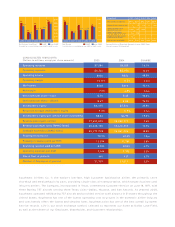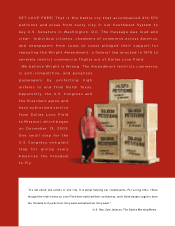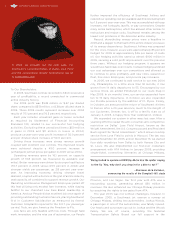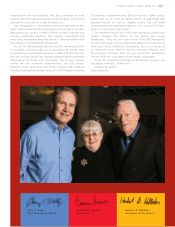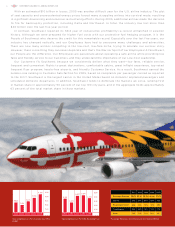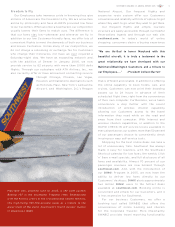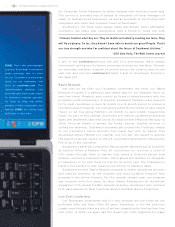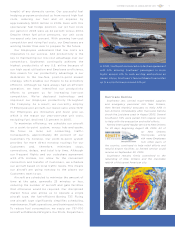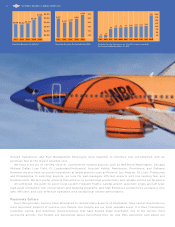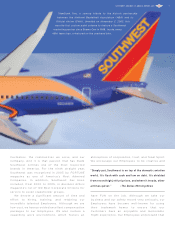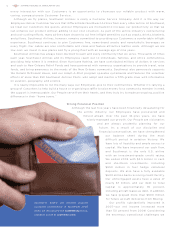Southwest Airlines 2005 Annual Report Download - page 8
Download and view the complete annual report
Please find page 8 of the 2005 Southwest Airlines annual report below. You can navigate through the pages in the report by either clicking on the pages listed below, or by using the keyword search tool below to find specific information within the annual report.
Hurricane Katrina
Southwest jets carried much-needed supplies
and emergency personnel into New Orleans,
then ferried thankful evacuees to Kelly AFB in
San Antonio immediately after Hurricane Katrina
struck the Louisiana coast in August 2005. Several
Southwest 737s were pulled from regular service
to help with the evacuation and relief efforts.
Katrina interrupted regular service to New Orleans
for 23 days, beginning August 28, 2005. All of
our New Orleans
Em p l oyee s , alo n g
with many Employees
from other parts of
the country, continued to help relief efforts and
rebuild airport facilities so limited service could
resume on September 20, 2005.
Southwest remains firmly committed to the
rebuilding of New Orleans and the inevitable
rebirth of this great American city.
length) of any domestic carrier. Our successful fuel
hedging program protected us from record high fuel
costs, reducing our fuel and oil expense by
approximately $900 million in 2005. Even with this
spectacular fuel hedge position, our jet fuel costs
per gallon in 2005 were up 24 percent versus 2004.
Despite these fuel price pressures, our unit costs
increased only two percent. With growing low-cost
competition and rising fuel costs, our Employees are
working harder than ever to prepare for the future.
Our Employees understand that low costs are
imperative to our success. And productivity is the
key to maintaining our low-cost advantage over our
competitors. Southwest continually achieves the
highest productivity of any U.S. airline because of
our high asset utilization and Employee proficiency.
One reason for our productivity advantage is our
dedication to the low-fare, point-to-point market
strategy, which enables our People to be extremely
efficient. Although we have always had an efficient
operation, we have intensified our productivity
efforts to prepare us for increasing low-cost
competition. We’ve deployed technology and
improved our Employee prod uctivity throughout
t h e C o m p a n y. As a re s u l t , we c u r re n t l y e m p l oy
7 1 Employees per aircraft, our lowest ratio since 1972!
Our Employees are innovative and never give up,
which is the reason our year-over-year unit costs,
excluding fuel, declined 1.5 percent in 2005.
To maximize efficiency, we schedule our aircraft
on a point-to-point system, versus hub-and-spoke.
We focus on local, not connecting, traffic.
Consequently, approximately 80 percent of our
Customers fly nonstop. Our point-to-point system
provides for more direct nonstop routings for our
Customers and, therefore, minimizes stops,
connections, delays, and total trip time. Although
our frequent flights and our codeshare agreement
with ATA Airlines, Inc. allow for the convenient
connection and transfer of Customers, we schedule
our aircraft based on local traffic needs. This means
our aircraft are going nonstop to the places our
Customers want to go.
Aircraft are scheduled to minimize the amount of
time at the gate, generally 25 minutes or less,
reducing the number of aircraft and gate facilities
that otherwise would be required. Our disciplined
market focus also allows us to operate a single
aircraft type, the fuel-efficient Boeing 737. Flying
one aircraft type significantly simplifies scheduling,
maintenance, flight operations, and training activities.
To reduce fuel consumption, we equip our 737-700
aircraft with Blended Winglets. Our Pilots, Dispatchers,
SOUTHWEST AIRLINES CO. ANN UAL REPORT 2005
In 2005, Southwest announced a codeshare agreement
with ATA, allowing Southwest passengers to book
flights aboard ATA to such exciting destinations as
Hawaii. Above, Southwest’s famous Shamu One nuzzles
up to a colorful Hawaii-bound ATA jet.
7

